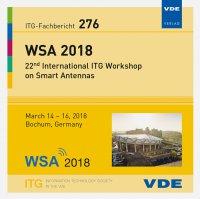A Statistical Approach for RF Exposure Compliance Boundary Assessment in Massive MIMO Systems
Konferenz: WSA 2018 - 22nd International ITG Workshop on Smart Antennas
14.03.2018 - 16.03.2018 in Bochum, Deutschland
Tagungsband: WSA 2018
Seiten: 6Sprache: EnglischTyp: PDF
Persönliche VDE-Mitglieder erhalten auf diesen Artikel 10% Rabatt
Autoren:
Baracca, Paolo; Weber, Andreas; Wild, Thorsten (Nokia Bell Labs, Stuttgart, Germany)
Grangeat, Christophe (Nokia Mobile Networks, Paris-Saclay, France)
Inhalt:
Massive multiple-input multiple-output (MIMO) is a fundamental enabler to provide high data throughput in next generation cellular networks. By equipping the base stations (BSs) with tens or hundreds of antenna elements, narrow and high gain beams can be used to spatially multiplex several user equipment (UE) devices. While increasing the achievable performance, focusing the transmit power into specific UE directions also poses new issues when performing the radio frequency (RF) exposure assessment. In fact, the spatial distribution of the actual BS transmit power strongly depends on the deployment scenario and on the position of the UEs. Traditional methods for assessing the RF exposure compliance boundaries around BS sites are generally based on maximum transmit power and static beams. In massive MIMO systems, these approaches tend to be very conservative, in particular when time averaging is properly considered. In this work, we propose to leverage the three dimensional spatial channel model standardized by the Third Generation Partnership Project in order to assess reasonably foreseeable compliance boundaries of massive MIMO BSs. The analysis is performed by considering BSs fully loaded and different configurations of active UEs per cell. Numerical results show that the statistical approach developed in this paper allows reducing to nearly half the compliance distance when compared to the traditional method.


